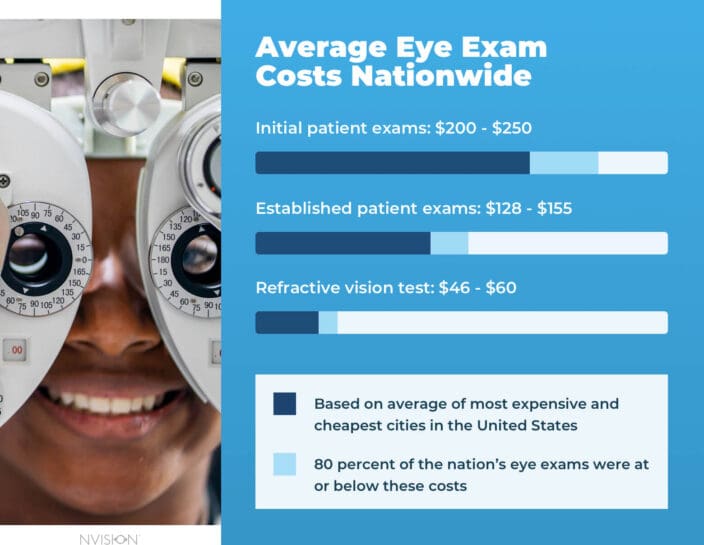Getting an Eye Exam Without Insurance: What to Expect (Costs and More)
Home / Insurance for Laser Eye Surgery & LASIK /
Last Updated:
If you do not have vision insurance, the cost of ophthalmologist visits without insurance may seem like an unnecessary expense. The average cost of an eye exam in the United States is around $200, which can be out of reach for many people. If you have an eye condition that requires regular checkups, you may spend more than that in a year.
Table of Contents
There are low-cost and free options to help you if you struggle financially since eye health is crucial to overall health. While there are online tests of your visual acuity, contrast, or color vision, ultimately self-diagnosis does not help you uncover potentially serious conditions like cataracts, macular degeneration, or glaucoma.
Eye health is very important. If you do not have appropriate glasses or contact lens prescriptions, you may suffer from eye strain, headaches, and trouble concentrating. Routine eye exams can also help you get early treatment and surgery for serious eye complications, like glaucoma or cataracts, before you suffer partial blindness.
Millions of Americans go without eye insurance, which covers the cost of annual eye exams. If you do not have vision insurance, what should you do to get an affordable cost of ophthalmologist visits without insurance?

How Much Does an Eye Exam Cost in the United States?
Estimates from FAIR Health suggest that eye exams are, in fact, the cheapest part of taking care of your eye health; however, they are still not a small amount of money if vision insurance does not supply assistance. National average costs are:
- $200 for initial patient exams.
- $128 for established patient exams.
- $46 for refractive vision tests.
You deserve clear vision. We can help.
With 135+ locations and over 2.5 million procedures performed, our board-certified eye surgeons deliver results you can trust. Your journey to better vision starts here.
These costs are the overall average of the most expensive cities and least expensive towns across the United States. However, they indicate what you can expect, in general, from an optometrist. If you have an underlying vision issue or the risk of developing a more serious vision disease, you may need to go to more frequent visits, which can become expensive without insurance.
However, FAIR Health also found that 80 percent of the nation’s eye exams were at or below these costs:
- $250 for initial patient exams
- $155 for established patient exams
- $60 for refractive vision tests
Eye exam frequency can impact your overall costs too. For the most part, frequency is based on age:
- Birth to 24 months (2 years): every 6 months or as recommended
- 2 to 5 years old: at 3 years old on average
- 5 to 19 years old: once per year
- 19 to 60 years old: every one to two years or as recommended, depending on eye health and refractive error
- 61 and older: annually, or as recommended by optometrist
When you need new glasses and a year’s supply of contact lenses, however, the costs begin to rapidly increase into the thousands of dollars. Getting help covering the costs of the exam and finding glasses or contact lenses for free or cheap can help people who are struggling financially and do not have vision insurance.
Financial Help to Get Regular Eye Exams and Corrective Wear

After the passage of the Affordable Care Act (ACA), vision insurance was slowly phased in as one of the health care marketplace’s options. However, oral and vision care are not considered essential health benefits for adults that standard health insurance must cover. Instead, the marketplace offers these types of insurance separately, with a tax credit as applicable based on income. For children, pediatric health insurance covers vision and dental care, as required by the ACA.
If you still cannot get vision insurance or missed the ACA application window, there are other options to get lower cost eye exams, financial aid for eye exams, and even free exams.
- Costco: Whether you have a membership to Costco or not, many of the stores have in-house optometrists who can conduct basic eye exams and give you prescriptions for glasses or contact lenses. To take advantage of their low-cost corrective eyewear, however, you must be a member. Without insurance, an eye exam at Costco will usually cost about $75 to $80.
- Walmart: Some Walmart stores have Walmart Vision Centers within them, where you can get an eye exam for $75 to $85 without insurance.
- Target: You can get a comprehensive eye exam at Target Optical Exact prices vary according to location, but an eye exam will cost between $60 and $100 without insurance.
- Groupon or other online coupons: Companies like Groupon and LivingSocial specialize in offering discounted products and services, including medical services. While many health services are cosmetic, you may be able to find a deal on eye exams, glasses, and/or contact lenses in your area.
If inexpensive or low-cost eye exams are out of reach, the National Eye Institute maintains a list of organizations that provide free eye exams and, often, free glasses.
- Optometry Cares: The AOA Foundation keeps a list of state-specific resources.
- EyeCare America has provided free eye exams to 1.8 million people since 1987.
- Lion’s Club International offers a vision screening program.
- Older adults may qualify for Medicare’s vision screenings to prevent diabetes-related eye conditions, macular degeneration, and glaucoma.
Self-Diagnosis and Online Tests Are Appealing but Ineffective

For those who know they have a refractive error — nearsightedness, farsightedness, or astigmatism — you can likely tell when you need new glasses or contact lenses because your existing vision problem will slowly progress until you need an updated prescription. This is a form of self-diagnosis that is useful if you do not otherwise need regular eye exams, so you can instead maintain your eye health with exams every other year. It is not recommended for adults to go more than two years without an eye exam.
If you do not know if you have some types of eye conditions and suspect that you may have an eye problem, you may search online for eye exams. There are several free online tests available to examine your visual acuity.
For example, one is in three parts and determines your visual acuity, your contrast vision, and your color vision, which can indicate not just refractive errors, but also help you understand if you have a more serious condition, like macular degeneration. Online astigmatism tests can help you learn more about specific refractive errors.
Some online companies even claim that they can renew your glasses or contact lens prescription online if you take their test, and you do not have to pay an exorbitant amount of money or keep an appointment with a doctor. This may seem like a great option for convenience and financial reasons, but it does not ultimately take care of your eyes’ overall health. Conditions like cataracts or glaucoma can be detected by routine, in-person tests and exams, which cannot be conducted online.
You deserve clear vision. We can help.
With 135+ locations and over 2.5 million procedures performed, our board-certified eye surgeons deliver results you can trust. Your journey to better vision starts here.
Does Telehealth Services Work for Eye Exams?
For the same reasons that online eye exams aren’t a good choice, telehealth services don’t work for eye exams.
If you have early stages of several serious vision conditions, you may still be able to see well enough, or you may treat the condition like a refractive error, believing you simply need stronger glasses. While you may qualify for an updated prescription, a telehealth eye exam doesn’t give the doctor the opportunity to fully examine your eyes and potentially detect concerning eye conditions or diseases.
Ultimately, self-diagnosis and telemedicine do not work as well for vision exams as they might for other conditions. So many eye conditions can be caught early and treated with routine exams.
Saving up and going in person to see an optometrist makes a huge difference. With the ACA’s introduction of vision insurance to the health insurance marketplace, affordable insurance coverage can help reduce your costs for eye exams, new glasses, and more.
Frequently Asked Questions About Eye Exam Costs
How much is the cost of ophthalmologist visits without insurance?
Exact prices vary according to location and retailer, but an average eye exam will cost $75 to $200 without insurance. While some doctors may charge up to $300 for an eye exam, retailers like Costco and Target offer relatively inexpensive eye exams.
How much does an eye exam cost with insurance?
Vision insurance plans usually cover the cost of an annual eye exam.
What is included in the cost of an eye exam?
In a comprehensive eye exam, the doctor will test your visual acuity, refraction, keratometry and topography, and the ability of your eyes to focus, team, and move. They will also take a patient history and assess your overall eye health. In some instances, supplemental testing may be recommended.
How can I pay less for an eye exam?
If you have vision insurance, it’s likely that the cost of your annual eye exam is fully covered. Consult your plan for specifics on your coverage. If you don’t have insurance, consider big-box retailers that offer discounted eye exams, such as Walmart, Target, or Costco.
You deserve clear vision. We can help.
With 135+ locations and over 2.5 million procedures performed, our board-certified eye surgeons deliver results you can trust. Your journey to better vision starts here.
References
- How Much Does an Eye Exam Cost? (September 9, 2016). Nerd Wallet.
- What Marketplace Health Insurance Plans Cover. Healthcare.gov.
- Vision Coverage. Healthcare.gov.
- I’ve Been a Costco Member for Eight Years, and One Little-Known Perk Makes It More Than Worth It. (April 11, 2018). Business Insider.
- Eye Exam in Seattle, WA. Groupon.
- Financial Aid for Eye Care. (June 2016). National Eye Institute (NEI), National Institutes of Health (NIH).
- State Specific Resources. Optometry Cares: The AOA Foundation.
- EyeCare America. American Academy of Ophthalmology (AAO).
- Vision Screening. Lion’s Club International.
- Your Medicare Coverage: Eye Exams. Medicare.gov.
- ZEISS Online Vision Screening. Zeiss.com.
- Astigmatism Test. OptoPLUS Eyecare Clinic.
- Online Vision Tests: Time Saver or Risk Maker? (August 7, 2018). Review of Ophthalmology.
This content is for informational purposes only. It may have been reviewed by a licensed physician, but is not intended to serve as a substitute for professional medical advice. Always consult your healthcare provider with any health concerns. For more, read our Privacy Policy and Editorial Policy.